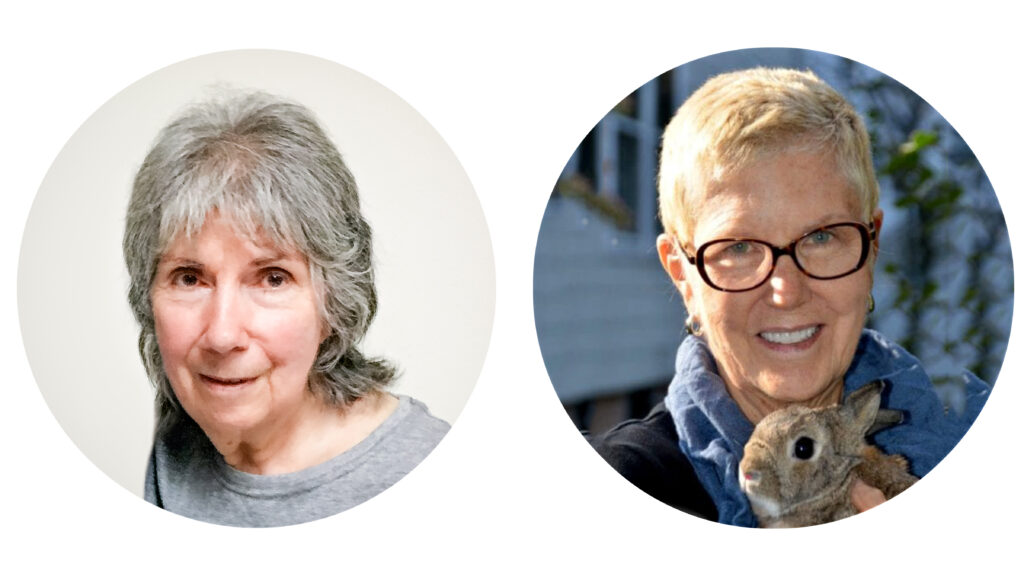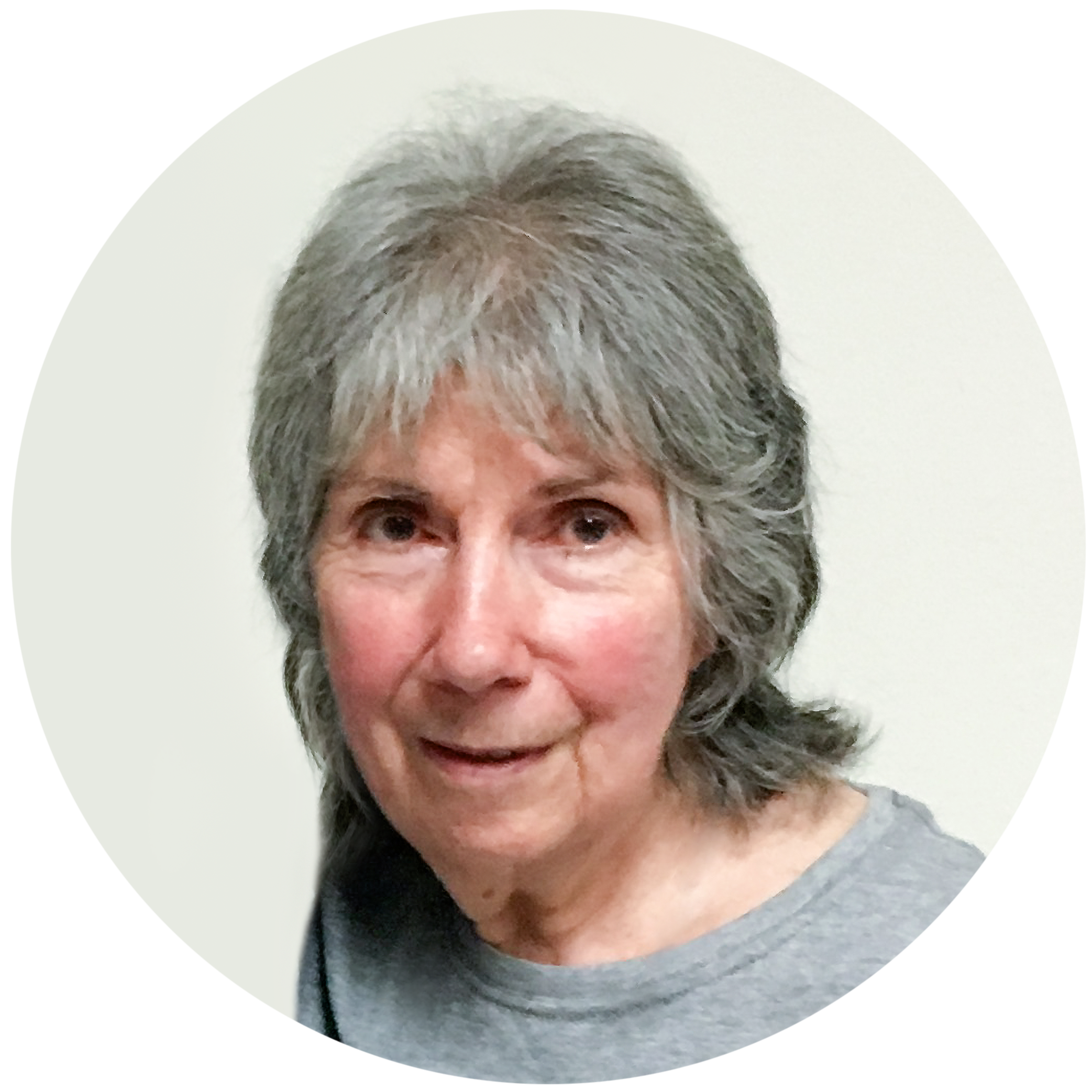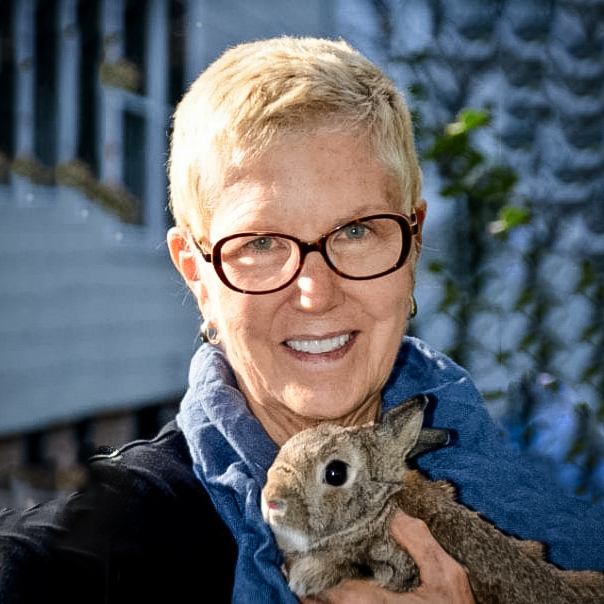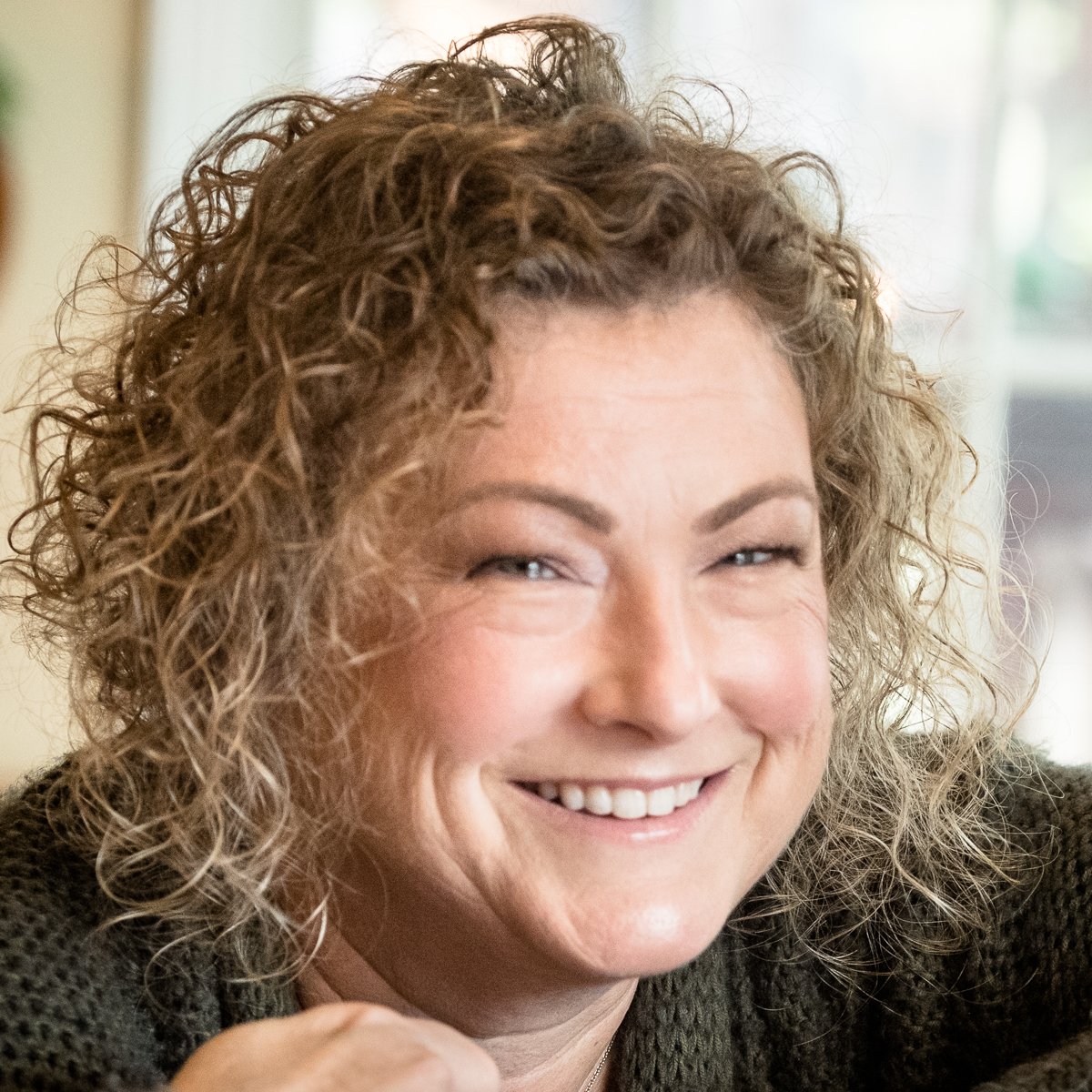Editor’s Note: Discover a rare and insightful conversation between Marinell Harriman—a humble pioneer who ignited a global movement for rabbit rescue, care, and advocacy—and her longtime friend and colleague, Mary Cotter. This edited transcription of Marinell’s interview at the 2014 House Rabbit Society Conference delves into Marinell’s transformative work, from introducing the concept of house rabbits with the publication of the House Rabbit Handbook in 1985 to founding House Rabbit Society in 1988. Her dedication continues to inspire individuals worldwide to rethink their views on rabbit companionship.
We at Rabbit.org Foundation appreciate Marinell ‘s permission to reproduce this look back at the beginnings of the house rabbit movement. Marinell has reviewed this transcription; some sections have been omitted for clarity and brevity.
Mary: Many of you may not have seen this little lady Marinell Harman. Marinell is the person who, along with a group of friends in California many years ago, started the House Rabbit Society. One of those friends was her husband Bob, who has worked collaboratively this entire time.
Margo DeMello asked me if I would come up and just chat with Marinell and have a conversation. Marinell’s really shy and she doesn’t like to talk about herself—and yet she’s a hero in all of our eyes.
I don’t know a lot about the early days because I’m from New York, and this all started in California. How did it happen? How come you were the beginner—where did that start?
Marinell: It started with a small rabbit little black and white rabbit hopping through our backyard. I had no idea what it was—I thought it may be a cat or something—but I went out and saw that it was a bunny.
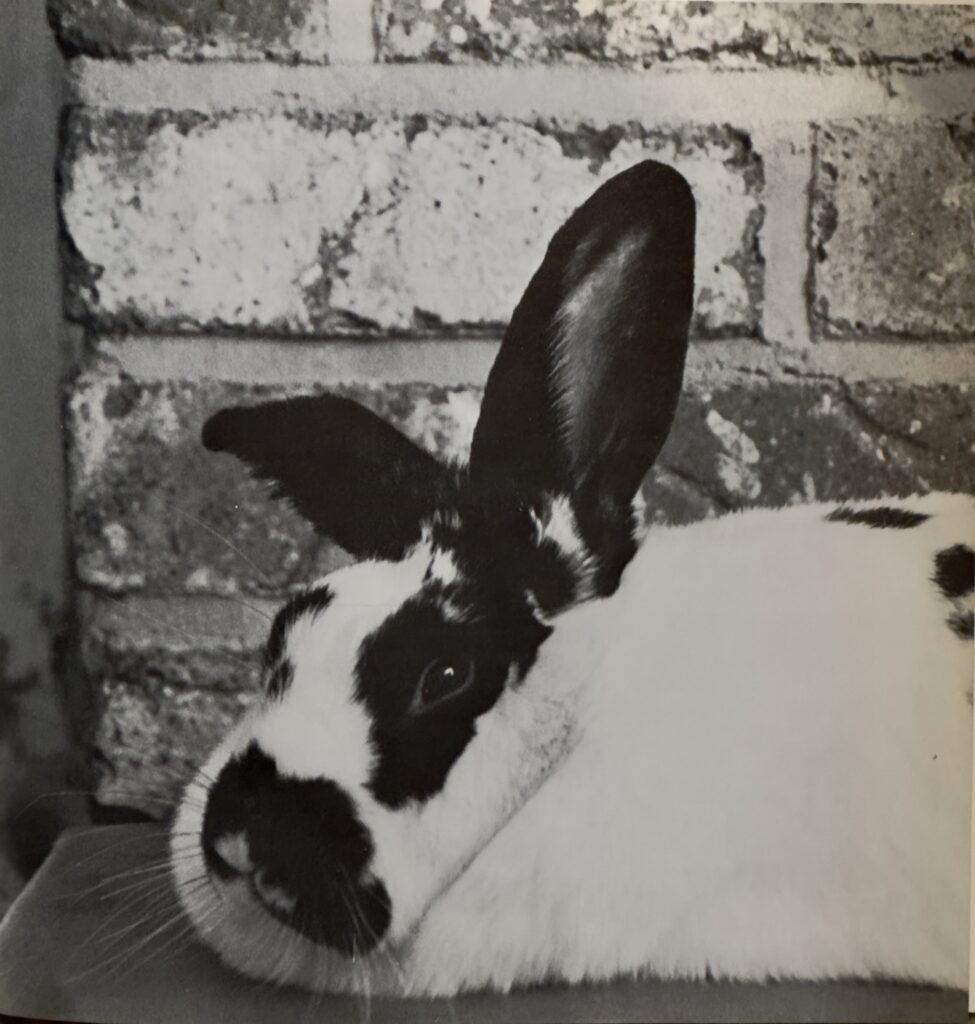
Mary: You had no rabbits of your own?
Marinell: Nothing. I had no concept what we were going to do! So I brought the bunny in and tried to figure out what we were going do with it. My husband came in from work and said, “well don’t tell the kids!” and not to expect too much because you know rabbits don’t have that much personality or brains. He was going to build a hutch in the backyard until we could find the owner and it turns out that hutch was never built. Herman (who we thought was a boy) turned out to be a girl and she took over the house in the next six months.
She was everything that all people cherish in first bunnies. Then when we lost her. Not knowing good diet, not knowing good care, not knowing all the things that we know today that everybody is able to avoid. When we lost her, we were so devastated.
As therapy, I started to write the House Rabbit Handbook. I thought the only way I could heal was to do something positive in her name and make her memory continue on. So I started writing once a week. I would interview people who had called… I’ll back up. We had a few pet supply stores in the Bay Area. I put up a little notice asking people to respond if they had a rabbit who lived in the house with them. Beth [Woolbright] responded, and a few others were the first responders on this plea. I found out that I wasn’t alone; I wasn’t the only one who ever had a bunny who lived in the house that was loved terribly.

Two years later, after the book came out, we got this response from people all over the country. [We] thought, well that’s really unusual; We bought a mailing list and just mailed out flyers thinking nobody would care about a rabbit living in the house! It was 1985.
So the book got out, and it was much more than we thought it would be as far as a response. I had people writing and saying please do a magazine! Then, we got a call from Amy Espie, who was the first rescuer and a participant in the House Rabbit Handbook. A friend of hers told us that the Oakland SPCA was going to be euthanizing rabbits the next day. I said, “Well why are you telling me this? There is nothing I can do about it.” She said, “You can go get them!”
That never occurred to me. I called Bob at work and I said, “Oh, there’re four rabbits at the Oakland SPCA and they’re going to be euthanized tomorrow.” He said, “Well we can’t let that happen can we?” So he told me to go get them. I went and got them, and that was the beginning of rescue. In the early days, we thought we were going to save them all. It was so much fun, you know? We found homes for these rabbits. We ran an ad in the newspaper. We don’t know if they were what we hoped were good homes, but we didn’t know anything about screening. But we did interview the people who came. As we started doing this, our veterinarian at the time said, “You know you’re going to rescue these little guys anyway and you love them dearly. Why don’t you start a nonprofit? You know at least you can get some support for what you’re doing.”
So that’s when we called back in the people who had helped with the House Rabbit Handbook and said, “Hey – you want to come and be on the board and be the first incorporators of the House Rabbit Society? So that’s how it evolved. Right after we incorporated we started sending out the House Rabbit Journal to the people who had bought the House Rabbit Handbook. We thought well this would be a good place to start. They responded and with their memberships and so on. We sent the journal to veterinarians, and they put them in their lobbies and actually I think the first um respondents from Veterinarians were from New York.
Then we had Susan Stark. She was one of our first satellite fosterers. Then Margo [DeMello] came in 1989 and she was my second satellite fosterer. Things just took off after that. Over the years, we accidentally started something that we’re very proud of and we’re so happy that it happened. But it’s the next people who came up and stepped up to the plate and started doing everything that made it all possible. I mean [HRS] wouldn’t be [what it is] today if it hadn’t been for all the wonderful volunteers who came along and took it to the next level.
Mary: All that’s true but we want to know about you! I have a couple of questions. When you said Herman. Did you rename Herman Herm or anything?
Marinell: I tried to but she already knew her name!
Mary: Okay. She was called Herman. You said she took over your home for six months. Is that all she lived? Did she live only six months?
Marinell: No; Two years. She lived two years with us. It only took her six months to take over the home. We thought we were going to keep her in the kitchen. We put newspapers down all over, then I noticed that oh she was only using one newspaper. That just seemed very unheard of; so I thought, well if she’s only going in one place, maybe a litter box?
Mary: This is like a parallel universe! I had exactly the same experience in New York where I adopted a rabbit from some nefarious person and I couldn’t bear to put him in a cage. I put him in my kitchen and he kept using one corner. So I thought, “What would happen if I put a box in the corner?” The same thing [happened!] It’s really weird; same time era and across the country. I guess it was like a serendipitous kind of synchronous movie started!
So did you ever in those days think about getting a companion for her?
Marinell: It never occurred to us. She seemed okay by herself. She left the kitchen and headed right to our bed, and she slept with us at night. She bounced around and did binkies.
Mary: Do you have any idea how old she was?
Marinell: Well, she was a youngster when I found her in the backyard. She was still growing.
Mary: So tell me about “house destruction.” Or as people call it “interior desecration.”
Marinell: [She chewed] a few phone cords. Back then, there really weren’t computers like there are now. Then [back in the late 1980’s,] the early days of the journal, we relied very heavily on the computer. In fact, this was before we had internet or email, and everything was by phone or what we could put in the mail. So getting that House Rabbit Journal out was really important to us and what’s really nice now is the continuity. Bob and I did it ourselves for the first 20 years. We published it for the first 20 years, and we had a wonderful staff. [Last year in 2013 we] handed it off to a new team of Journal editors so it doesn’t have to be us. It doesn’t live and die with us. It will go on; and that’s what we were hoping for — that everything that has been started will continue.
Mary: So what was the most surprising thing to you about having a rabbit in your house? Did people criticize you for it? Were you renting from a landlord?
Marinell: Yes, yes.
Mary: You were?!? Did your lease prohibit pets?
Marinell: Yes it did.
Mary: Did your landlord ever find out? Make a surprise plumbing visit?
Marinell: No; By the time we moved we had 82 rabbits!
Mary: Oh my goodness! In this house? Did the landlord ever find out?
Marinell: Our landlady’s mother-in-law lived next door, and we were so careful.
Mary: So you couldn’t have kept it secret for that long, could you?
Marinell: We did.
Mary: They never came in to inspect? or nothing?
Marinell: No. We were lucky.
Mary: How many years did you re-sign that lease? They didn’t know you had 82 rabits?
Marinell: We didn’t resign a lease; It was month to month. But the only reason we were evicted was because the landlady was giving the house to her daughter for a wedding present .
Mary: Did they see you move 82 rabbits out?
Marinell: No. We slipped them out in the night!
Mary: Did you really?!?
Marinell: Yes.
Mary: Who did it? Did you do it yourselves?
Marinell: The whole group did and family as well
Mary: There’s something else. I have heard this phrase a lot; It’s “sitting around a kitchen table.” Everybody talks about the early days as a group of friends sitting around [a kitchen table.]What was that about?
Marinell: Beth Woolbright, Betty Tsubomato, Amy Espie who passed away, Ron Westman and his wife, Donna Dugay. We sat around our dining table and just talked. We had kept in touch ever since the House Rabbit Handbook. So when it it was time to start this organization, we just got the same people to come together and be signers.
Mary: How did the idea of chapters come to you, or or did it come to somebody else later?
Marinell: I think Beth was heavily involved in developing the criteria for chapters. Then when Margo came in she got everything really organized and we set up some rules and things like that. We saw an attorney for the first time because I was getting kind of scared that maybe we weren’t doing this all right. She said the larger you grow the more rules you have to make and so that seemed kind of scary.
We had to make rules and I was amazed at Margo because she would have people actually have to sign applications to become an educator. When I was doing it, you know, heading the organization, I was just so grateful for anybody who was going to show up and volunteer. I accepted everybody’s help for any reason whatsoever. Why risk losing them with [rules] so Margo got some standards and some applications [in place.] I thought she’s not going to have anybody volunteering!
It was great because if [people] have to fill out an application, that means it’s worth something – it’s really worth something.
Mary: Back in those days, there weren’t rabbit vets. How did you deal with getting rabbit veterinary care?
Marinell: We had a good rabbit vet— Dr Marla Geisler was the first person we knew of that took care of rabbits. Then, Dr Carolynn Harvey went to work at the same hospital. She was fresh out of school at that time, and we thought of her as the brainy new veterinarian who was kind of aloof. But she was very smart!
So we thought well you know she solves problems. Then, over the next two or three years, she just became our vet–our go-to, warm-and-friendly, problem-solving vet. She talked things through. She thought out loud. That was really important to us. Instead of going off into another room, taking the bunny and not telling us anything about it, she would think out loud so we could participate.
Mary: Was [Dr Harvey] or anyone else you worked with collaborative? In the sense of interested in your input?
Marinell: Yes absolutely. She’s been great all these years, and the other thing that she has done is recruit other vets to help us. Then she was very instrumental in getting the [March 1997 first of its kind rabbit] veterinary conference going.
Mary: In the early days, what were some of the hurdles that you had to overcome? Did you ever think, “Damn, what have I started? I can’t can’t keep doing this!”
Marinell: I would have times that I would feel pretty overwhelmed with the amount of work. There was a time when I thought I had to do it all — I didn’t know how to delegate. That was about the next people coming in. That’s what Margo was great at—delegating—and getting other people to do work. I thought I had to do it all. I couldn’t leave the house unless all the work was done. So that was letting go; having to do that was hard.
Mary: What would you consider some milestones?
Marinell: Publishing the House Rabbit Handbook [December 1985], starting the organization [January 1988] and starting the House Rabbit Journal [May 1988]. Those are three huge milestones.
Mary: What are some other things that you might consider milestones?
Marinell: Getting the money together [from 1998-2000] to do the [rabbit] shelter in Richmond .
